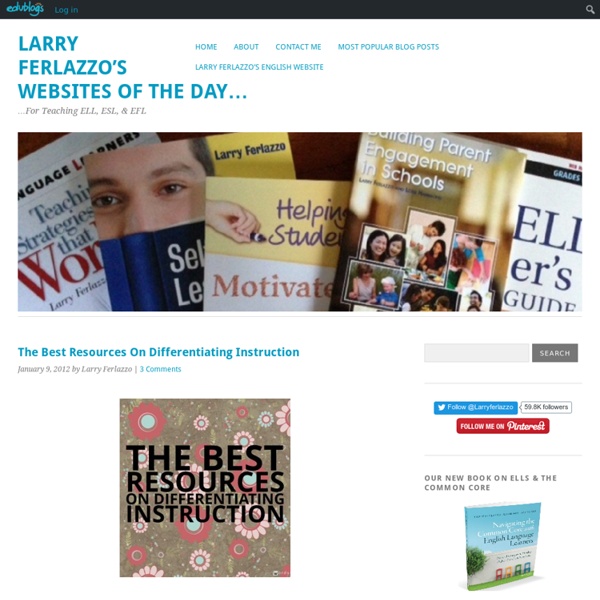Using Digital Tools for Differentiation
Direct Address to this Page: Anyone who has worked in education for any length of time knows just how important it is for teachers to create differentiated classrooms. If schools are truly working to ensure success for every student, learning experiences need to be customized and aligned to student interests, needs, and unique learning styles.
An Interview with Grant Wiggins: The Power of Backwards Design
When Grant Wiggins and Jay McTighe wrote Understanding by Design (UbD) they did what no other educator had ever accomplished. They unequivocally cast assessment in the central role of teaching and learning by making the forceful argument that testing should not be the afterthought of instruction, but the central point of instruction. After all, how do we know students have learned anything after we have taught them if we don't assess them on what we hope they have learned? Since Dr. Wiggins helped Dr.
Teaching the Gifted and Talented: 33 Websites Where You Can Find Good Resources
I wish the Internet was available to me as a kid in elementary school. In New York City, where I attended kindergarten through sixth grade, they called the gifted and talented class "SP". I remember being put into a class to learn French, but very little else.
Digital Differentiation
Technology is a tool that can be used to help teachers facilitate learning experiences that address the diverse learning needs of all students and help them develop 21st Century Skills. At it's most basic level, digital tools can be used to help students find, understand and use information. When combined with student-driven learning experiences fueled by Essential Questions offering flexible learning paths, it can be the ticket to success. Here is a closer look at three components of effectively using technology as a tool for digital differentiation.
15 Options for Creating Screen Capture Images and Videos - Including on Chromebooks
For the next few days I'm taking some time off to relax, play with my dogs, and ski with friends. Rather than leave the blog dormant for a few days, I'm re-running some of the most popular posts of the year. TechSmith Snagit is a screen capture tool from the producers of the popular screencasting tools Jing and Camtasia. TechSmith Snagit is a Chrome app and extensions that allows you to capture all or part of screen then draw and write on your screen capture. The Snagit Chrome extension is what allows you to capture your screen.
Differentiation - tools, tips and resources
Differentiation is an important aspect of education. Students learn differently, have different needs, different backgrounds, different skills, different ability levels, different interests and more. As educators, we try to create engaging lesson activities that provide a variety of learning experiences and allow students to demonstrate their learning in different ways. Differentiation should occur in both how students learn and gain knowledge and skills, and in how they demonstrate and are assessed on what they have learned. “In the practice of education, differentiation is defined as working to address the abilities, interests, and needs (both perceived and real) of individuals.
CSU NGSS community: Science and Literacy Learning
Web Resources in STEM Education-Examples Created by CSU Faculty Dr. Ivan Cheng, Department of Secondary Education, CSU Northridge
Ways To Differentiate Instruction - Classroom Q&A With Larry Ferlazzo
(This is the first post in a two-part series on differentiation) I posed this question last week: "What is the best advice you can give to a teacher about differentiating instruction?" I've shared my response in an Ed Week Teacher article that I've co-authored with my colleague, Katie Hull Sypnieski. It's titled "The Five By Five Approach To Differentiation Success." I'll limit my contribution here to sharing a useful link to The Best Resources On Differentiating Instruction.
Ten Takeaway Tips for Teaching Critical Thinking
Suggestions from educators at KIPP King Collegiate High School on how to help develop and assess critical-thinking skills in your students. Ideally, teaching kids how to think critically becomes an integral part of your approach, no matter what subject you teach. But if you're just getting started, here are some concrete ways you can begin leveraging your students' critical-thinking skills in the classroom and beyond. 1.
50 Little-Known Ways Google Docs Can Help In Education
Google Docs is such an incredible tool for college students, offering collaboration, portability, ease of use, and widespread acceptance. But there are so many options, both hidden and obvious, that there’s a good chance you’re not using Google Docs to its fullest capability. We’ve discovered 50+ great tips for getting the most out of Google Docs as a student , with awesome ideas and tricks for collaboration, sharing, and staying productive. Access your documents from anywhere : Whether you’re in your dorm room or the school library, you can access your Google Docs.
Guide to special needs apps
Complete guide to educational and special needs apps With over 300,000 apps it's easy to become overwhelmed by the number of app choices. It's also easy to spend a small fortune on a lot of useless apps. As a special needs parent I wanted to get right to the "good stuff" and figured you did too. Check out our guide that breaks down the best of the apps by skill set so you can easily find and buy apps that most benefit your child. Great for kids with autism, ADHD, apraxia, learning disability, sensory issues and more.



